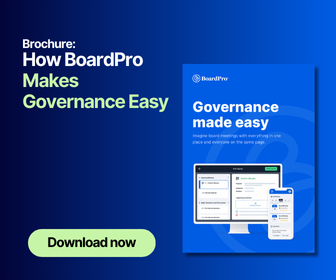How do I stop my CEO burning out?
The CEO burnout epidemic: The board’s role
Over the past month, several high-profile leaders have stepped back or down from their leadership position. All of them cite burnout as the key reason for wanting – or needing – a timeout.
On the one hand, this signifies a positive response to the movement towards improving psychological safety and mental health and well-being in the workplace. More people, especially men, are feeling enabled to raise their hand and ask for help. These changes signify a healthy change in an organisation's culture.
On the other hand, it is a stark reminder to boards that it has responsibility for the health and well-being of its CEO as much as it does for all employees.
There are two elements that are important for governance: the need for boards to positively take steps to ensure the well-being (physical and psychological) of employees, including the CEO; and the need for all boards to ensure an effective succession plan is in place for the CEO. Taken together, and in the context of the CEO, these activities can be considered as managing key person risk.
What is burnout?
In 2019, the World Health Organization defined burnout as:
“… a syndrome conceptualised as resulting from chronic workplace stress that has not been successfully managed. It is characterised by three dimensions:
- feelings of energy depletion or exhaustion;
- increased mental distance from one’s job, or feelings of negativism or cynicism related to one's job; and
- reduced professional efficacy.
Burn-out refers specifically to phenomena in the occupational context and should not be applied to describe experiences in other areas of life.”
(source: https://www.who.int/news/item/28-05-2019-burn-out-an-occupational-phenomenon-international-classification-of-diseases
It’s probably something that you’ve felt previously and it’s no wonder that, post-Covid, many leaders are experiencing these feelings. Working from home and the need to constantly be ‘on’ – particularly for leaders like Mark McGowan (former Premier of Western Australia) – it never really felt like there was time off from work. Dealing with a crisis spanning years, rather than days, is guaranteed to leave most people depleted once it subsides.
For public-facing leaders, like AFL Head Coach Damian Hardwick, extended pressure to perform from media, fans, and the boss further contributes to being in a sustained fight-or-flight cortisol response.
Common symptoms of burnout can include:
- Feeling depleted of energy or feeling exhausted: for example, still feeling tired even after a full night’s sleep; being slower to think and react; feeling emotionally overextended by your work.
- Increased mental distance from one’s job, or feelings of negativism or cynicism related to one's job: for example, feeling that you no longer care about your job, your fellow employees, or your customers; lost enthusiasm for your job.
- Reduced professional efficacy: feeling like your job is meaningless and that it doesn’t make any difference; feeling incompetent; losing confidence in your abilities.
The health impacts from burnout
It is becoming more well-known that a sustained cortisol stress response can lead to negative health responses in all aspects of the body, not to mention the impact on workplace performance.
These health impacts are one of the reasons why amended work health and safety laws (in Australia) now require companies to proactively manage psychosocial risks and hazards in the workplace. It also makes good business sense.
Managing CEO mental health and safety
In addition to managing the physical health and safety for all employees, you now must include the identification, assessment, and management of psychosocial risks in the workplace through consultation with all levels of the organisation. Do not forget about the CEO.
Provide information and resources to all employees, including the CEO, on how they can manage workplace psychosocial risks.
It may be valuable, for more than just mental health reasons, to provide the CEO with access and time to work with an appropriately capable coach or counsellor.
Check-in regularly with the CEO about their mental state and workload. Usually, this is the Chair’s remit and is facilitated with regular one-to-ones between the Chair and CEO.
As a board, be conscious of the number of strategic ‘priorities’ you commit the organisation to. Too many (relative to your organisation’s resources and capabilities) and you’re heading towards mass burnout from the beginning. Sometimes it’s better to do fewer things well than to do many things average or poorly.
Managing CEO succession
Having a plan for what to do when your CEO retires, needs to take a long break, or is suddenly unable to fulfil their role, is an important job for the board. You may never end up using it; however, it will help you to prepare for that moment when your CEO is absent.
Whether the CEO’s successor comes from within the organisation, externally from candidates you may have your eye on, or a nominated board member to be a short-term backstop, have a go-to plan in your back pocket. It’s one last thing to worry about during a potential crisis.
What can you do?
An ounce of prevention is worth a pound of cure, especially when it comes to burnout. Being cognisant of burnout as an increasing phenomenon will help to destigmatise it and raise the level of importance of psychosocial well-being in the workplace. Here are some hands-on examples of what boards, committees, chairs, and CEOs themselves can do about preventing and managing burnout.
What Boards can do:
- Be conscious of the expectations placed on the CEO and organisation (relative to the resources and capabilities of the organisation). Focus on fewer strategic priorities, done really well.
- Remember that there is a person behind the position; be conscious that they too are bringing their whole life to their role, like every other employee.
- Be vigilant for the CEO exhibiting signs of burnout or fatigue. If you see something, say or do something.
- Be conscious of the organisational culture and the impact this may be having on the psychosocial health of the CEO and other employees.
What governance or risk committees can do:
- Ensure your approach to workplace health and safety includes psychosocial safety, and that the CEO is considered and included in workplace evaluations and WHS risk minimisation activities.
- Ensure that the governance framework and reporting do not overburden the CEO. The more time spent on reports, the less time spent delivering on the strategic plan.
- Succession plan: Ensure that there is a comprehensive succession plan in place for the CEO, for both planned and unplanned absences.
- Ensure the CEO is taking their required annual leave. This is a psychosocial health issue as much as a financial liability management issue.
What Chairs can do:
- Be conscious of the signs of burnout (shared above). Take action if signs are present in the CEO.
- Proactively enquire about the mental state of the CEO in your one-to-one conversations. Do things to actively support the mental well-being of the CEO.
- Ensure the CEO is able to take leave, that they are taking leave, and that they are fully switching off whilst on leave.
What CEOs can do:
- Be alert to your state of mental health and your feelings towards your role. Take active steps to improve your mental health if you’re feeling it slip.
- Be sure to take your personal leave. Plan for time off work; having a trip to look forward to may be helpful.
- Don’t try to be the hero and push through. Sometimes you have to slow down to go faster.
- Be aware of the example that you are setting for your team and the Board.
Like many risks, burnout is something that can be proactively managed, as long as the contributory factors are identified and controlled effectively. Managing key person risk is an important risk management task for all boards; is it on your agenda?
Additional Reading
https://www.safeworkaustralia.gov.au/safety-topic/managing-health-and-safety/mental-health
If you're looking for a tool to streamline your Board processes, check out BoardPro - an all-in-one software solution designed specifically for Boards and busy CEOs!
Schedule a demo with our team today and begin to experience a whole new way of meeting.
Share this
You May Also Like
These Related Stories

Why a good board needs a solid connection with the CEO

Tackling the Tough Stuff as a Board


